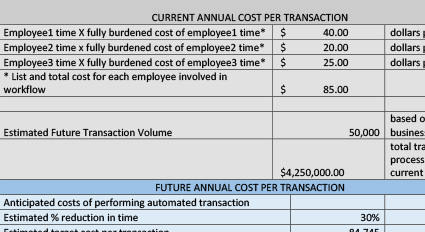How to Approach Workflow ROI
By Mike Raia ![]() | Published October 16, 2019
| Published October 16, 2019
After fifteen years of working with customers to improve workflow efficiency and productivity, we can honestly say that every workflow situation is unique. There are similarities among every new hire process, expense request process, change request process, etc., but no one handles the same process precisely the same way.
While we offer templates to help kickstart these kinds of processes, the point is not to download the template and turn it on. Instead, the templates are a starting point adapted to your organization's way of working.
When people ask us about the potential ROI (Return on Investment) they can expect from any particular workflow automation project; we don't like to throw out a number since there are so many variables involved. Making the business case for workflow is something we often help with, but, ultimately, it's about the unique pain points and benefits for each company.
For example, compare a product management team automating its product development workflow to speed time to market to an HR team looking to onboard employees faster and more consistently. Very different processes with very different KPIs, to be sure, but that's just the start.
In the case of the product development workflow:
- There could be 50 people involved or 5.
- The product could be high-margin or low-margin.
- There could be 100 steps or 25 steps.
- A process could be partially-automated or completely manual.
- There could be useful data on the efficiency of the current process or none at all.
Also, the goals of any particular automation project could be varied:
- Faster transaction processing
- Improved employee satisfaction
- Error reduction
- Compliance requirements
- Reduction in IT development/maintenance time
Because of all these myriad factors, it's helpful for the process owner to determine the unique ROI opportunity available with automation.
Fortunately, we have a few tools that will help you determine the potential impact of a workflow automation project in your unique business environment.
Our "Workflow ROI Guide" provides sample worksheets to apply to your processes to determine the hard and soft benefits of automating your workflow. You can download the guide for free.

Sample from the "Workflow ROI Guide"
Another tool is our ROI Calculator, which focuses on possible savings specific to requests. You enter some information about the estimated cost of a request, and we calculate how much you could save each month in time and cost.
Understanding how you can impact the company's bottom line by improving your business processes is a good first step.
Tags
ROI Workflow return on investment TCO total cost of ownership
Categories
Workflow Ideas Business Ideas

Mike Raia
Marketing the world's best workflow automation software and drinking way too much coffee. Connect with me on LinkedIn at https://www.linkedin.com/in/michaelraia/